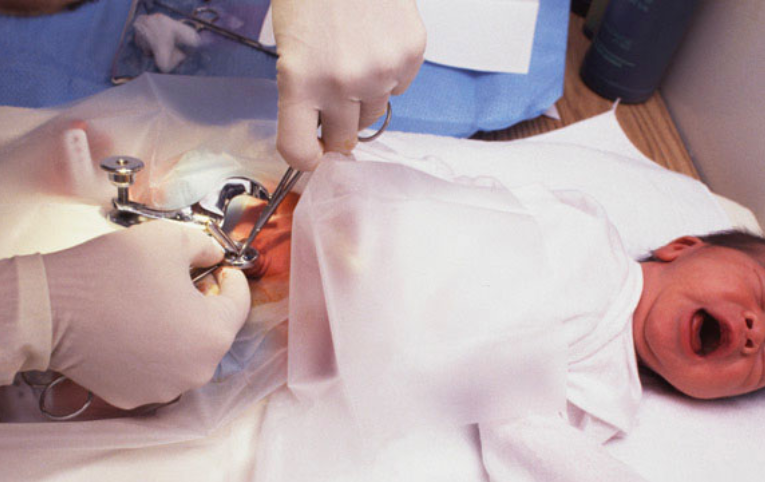Understanding Urinary Tract Infections In Children And How Delayed Circumcision Could Be A Risk Factor | Paediatrician, Dr. Oluwole Ayodele

A consultant paediatrician at the Lagoon Hospital, Ikeja, Lagos, Dr. Oluwole Ayodele, in a chat with PUNCH talks about the risk factors for urinary tract infections in children.
What is urinary tract infection?
Urinary tract infection occurs when microorganisms in certain high proportions are found in any part of the urinary tract. The urinary tract is the part of the body extending from the kidneys through the ureters, to the bladder and terminating at the urethra opening on our genitals.
The kidneys filter the blood to form urine, which is channelled through the ureters and stored in the bladder (urine bag). When adequate quantity is formed, the person feels the urge to urinate and urine is then passed out through the urethra opening on the genitals.
Is it true that females are more susceptible to UTI than males?
Yes, it is true. Females are more susceptible to UTI, particularly after the first year of life because of the female anatomy, with the close proximity of the vagina to the anus as most bacterial infections originate from bacteria in faeces. The urethra is shorter in females and shortens the distance to the bladder. The lower urethra is contaminated by vaginal and faecal organisms.
How true is the general belief that poor toilet hygiene is a risk factor for UTI?
Yes, it is true; but there are other factors, including withholding urine for too long. Urine normally contains bacteria whose quantity is not high enough to cause an infection. However, if the urge to urinate is suppressed for a prolonged period, the bacteria are able to multiply as urine serves as a growth medium for bacteria.
Another factor is delayed circumcision. The longer circumcision is delayed, the higher the risk of infection because the foreskin harbours a lot of dirt and bacteria and the risk of these bacteria getting into the urethra is higher without circumcision.
Others risk factors are abnormal formations along the urinary tract, bacteria introduction through genital openings by insertion of substances or foreign bodies, cleaning the anus wrongly after defecation by wiping from back to front in girls, which allows bacteria to be pushed into the urethra; constipation, excessive antibiotics use, voiding problems in children, presence of some medical conditions like nephrotic syndrome, sickle cell and malnutrition.
READ ALSO: What You Should Know About Urinary Tract Infection (UTI)
Is it true that wearing tight clothes can also predispose, especially young females, to UTI?
Yes, it is true and this is because wearing tight clothes, especially if not cotton materials, allows bacteria to grow more rapidly.
What are the general symptoms of UTI in children?
The symptoms include fever, poor feeding, excessive crying, vomiting, failure to grow. In older children, they include vomiting, abdominal pain, diarrhoea, fever, smelly urine, frequent urination, pain on urination, bed-wetting, dribbling of urine and poor urine stream.
Are the symptoms the same when the kidneys and bladders are infected?
Kidney infections are more serious with high fever, restlessness, vomiting, severe abdominal pain, flank pain. Some children may convulse; there is usually a need to admit the child. Bladder infection is less serious with no fever; there is rarely vomiting and there is usually no need for the hospital admission.
For how long can UTI go unnoticed in kids?
A child can have asymptomatic bacteriuria, a form of UTI, for so long without showing signs or symptoms.
What are the different ways of diagnosing urinary tract infection in children?
UTI is diagnosed using urine samples for various tests. In urine culture, collection of urine in an appropriate manner is crucial to diagnosis. This method is the best method for diagnosis. Urine is taken to the laboratory and the result comes out in 48 to 72 hours.
The urinalysis or dipstick test is instantaneous. It cannot confirm UTI but can suggest it and is useful in rural settings without laboratory facility. Microscopy takes a few minutes to get the result. It cannot confirm or rule out UTI with utmost certainty. Other tests are done to find out if there are abnormalities along the urinary tract.
When are CT scan and kidney and bladder ultrasound necessary for kids with UTI?
They are necessary if UTI is recurrent, if it is not responding well to treatment, if the first UTI is accompanied by fever and if there is suspicion of urinary tract abnormalities. They are also necessary if the UTI is responding poorly to treatment, if the ureters are inappropriately dilated, if there is an enlarged kidney or unusual bladder fullness and if there is a suspicion of kidney injury with scars.
Are there complications that may arise from late treatment of UTI in kids?
UTI may cause fever, abdominal pain, vomiting and dehydration. Generalised infection may originate from a kidney infection. Abscess formation around the kidney can occur too. Kidney infection in children less than five years can result in kidney scar formation and progressive kidney damage. Other long-term complications of kidney infection are hypertension and kidney failure in adulthood. These result from the scar caused by the childhood infection.
What are the treatment options available for them?
Dehydration is treated by increased fluid intake; kidney scar formation is managed by a careful follow-up into adulthood as scars cannot be treated or reversed. Prevention is the key. Kidney failure requires long-term dialysis and kidney transplant.
READ ALSO: Medical Specialists Explain Why Some Children Develop Brain Malfunction
Is surgery necessary?
Sometimes, but rarely. If there are obstructions and or abnormalities along the urinary tract preventing the seamless flow of urine from the kidneys, through the ureters to the bladder and through the urethra, surgery may be necessary.
Are there home remedies for UTI?
There should be adequate water intake. Some experts have advocated the use of cranberry juice. Healthy habits should be practised.
Are there habits parents should discourage in children to avoid UTI?
Children should not hold urine for too long. When children use the toilet, they should wipe from the front to the back and not the other way. They should use cotton underwear, avoid tight-fitting underwear and change underwear frequently.


